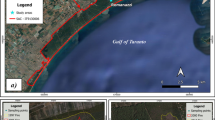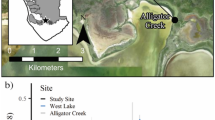Abstract
The Rainwater Basin (RWB) provides critical habitat for many species of migrating waterfowl during spring migration. Conservation planners are currently using a bioenergetic approach to evaluate waterfowl habitat needs for this region, yet forage availability is currently unknown. We evaluated wetland-derived seed availability on publically-managed wetlands to determine mass available in emergent plant communities dominated by annual moist-soil species (MSA) and perennial moist-soil (MSP) stands. Prior to spring migration, 10-cm deep core samples were collected from 12 wetlands (n = 97) in 2010 and 13 wetlands in 2011 (n = 107) across 5 counties throughout the RWB. Available seed biomass for all areas sampled was 685.7 ± 45.9 kg/ha). Between these two common plant communities, mean seed mass was significantly greater (Z = 4.78, P < 0.0001) in MSA stands (\( \overline{x} \) = 907.2 ± 84.6 kg/ha) than in MSP stands (\( \overline{x} \) = 488.7 ± 33.5 kg/ha). Carrying capacity estimates can now be estimated for publically-managed RWB wetland habitats by determining if stands are dominated by annual or perennial species. In addition, land managers can now determine if management treatments will maximize seed biomass for spring migrants based on stand composition during the growing season.






Similar content being viewed by others
References
Anderson JT, Smith LM (1998) Protein and energy production in playas: implications for migratory bird management. Wetlands 18:437–446
Anderson JT, Smith LM (1999) Carrying capacity of diel use of managed playa wetlands by nonbreeding waterbirds. Wildlife Society Bulletin 27:281–291
Anderson JT, Smith LM, Haukos DA (2000) Food selection and feather molt by nonbreeding American green-winged teal in Texas playas. Journal of Wildlife Management 64:222–230
Ankney CD, Afton AD (1988) Bioenergetics of breeding northern shovelers: diet, nutrient reserves, clutch size, and incubation. Condor 90:459–472
Ankney CD, Afton AD, Alisauskas RT (1991) The role of nutrient reserves in limiting waterfowl reproduction. Condor 93:1029–1032
Anteau MJ, Afton AD (2004) Nutrient reserves of lesser scaup (Aythya affinis) during spring migration in the Mississippi flyway: a test of the spring condition hypothesis. Auk 121:917–929
Anteau MJ, Afton AD (2009) Lipid reserves of lesser scaup migrating across a large landscape are consistent with the “spring condition” hypothesis. Auk 126:873–883
Arnold TW, Devries JH, Howerter DW (2010) Factors that affect renesting in mallards (Anas platyrhynchos). The Auk 127:212–221
Arzel C, Elmberg J, Guillemain M (2006) Ecology of spring-migrating Anatidae: a review. Journal of Ornithology 147:167–184
Baldassarre GA, Bolen EG (1984) Field feeding ecology of waterfowl wintering on the Southern High Plains of Texas. Journal of Wildlife Management 48:63–71
Baldassarre GA, Bolen EG (1986) Body weight and aspects of pairing chronology of green-winged teal and northern pintails wintering on the Southern High Plains of Texas. Southwestern Naturalist 31:361–366
Baldassarre GA, Whyte RJ, Bolen EG (1983) Dynamics and quality of waste corn available to postbreeding waterfowl in Texas. Wildlife Society Bulletin 11:25–31
Barney ES (2008) Change in availability and nutritional quality of postharvest waste corn on waterfowl staging areas near Long Point, Ontario. Thesis, University of Western Ontario, London, Canada
Beas BJ, Smith LM, LaGrange TG, Stutheit R (2013) Effects of sediment removal on vegetation communities in Rainwater Basin playa wetlands. Journal of Environmental Management 128:371–379
Bilderback DE (1978) The development of the sporocarps of Marsilea vestita. American Journal of Botany 65:629–637
Bishop AA, Vrtiska MV (2008) Effects of the Wetland Reserve Program on Waterfowl Carrying Capacity in the Rainwater Basin Region of South-Central Nebraska. Final report. Conservation Effects Assessment Project. Natural Resources Conservation Service. Washington DC
Blem CR (1976) Patterns of lipid storage and utilization in birds. American Zoology 16:671–684
Bonnet X, Bradshaw D, Shine R (1998) Capital versus income breeding: an ectothermic perspective. Oikos 83:333–341
Boos M, Zorn T, Maho YL, Groscolas R, Robin JP (2002) Sex differences in body composition of wintering mallards (Anas platyrhynchos): possible implications for survival and reproductive performance. Bird Study 49:212–218
Bowyer MW, Stafford JD, Yetter AP, Hine CS, Horath MM, Havera SP (2005) Moist-soil plant seed production for waterfowl at Chautauqua National Wildlife Refuge, Illinois. American Midland Naturalist 154:331–341
Brasher MG, Steckel JD, Gates RJ (2007) Energetic carrying capacity of actively and passively managed wetland for migrating ducks in Ohio. Journal of Wildlife Management 71:2532–2541
Buckley CE (1989) The nutritional quality of selected row crop and moist-soil seeds for Canada geese. Thesis, University of Missouri
Checkett JM, Drobney RD, Petrie MJ, Graber DA (2002) True metabolizable energy of moist-soil seeds. Wildlife Society Bulletin 30:1113–1119
Cox RR Jr, Johnson DH, Johnson MA, Kirby RE, Nelson JW, Reynolds RE (2000) Waterfowl research priorities in the northern Great Plains. Wildlife Society Bulletin 28:558–564
Davis JB, Guillemain M, Kaminski RM, Arzel C, Eadie JM, Rees EC (2014) Habitat and resource use by waterfowl in the northern hemisphere in autumn and winter. Wildfowl 4:17–69
Delnicki D, Reinecke KH (1986) Mid-winter food use and body weights of mallards and wood ducks in Mississippi. Journal of Wildlife Management 50:43–51
Devries JH, Brook RW, Howerter DW, Anderson MG (2008) Effects of spring Body condition and age on re production in Mallards (Anas platyrhynchos). The Auk 125:618–628
Drahota J (2012) Rainwater Basin seed availability, depletion, and waterfowl response during spring migration. University of Nebraska at Kearney, Nebraska. USA
Drahota JL, Bishop A, Walters R (2004) Rainwater Basin wetland complex south-central Nebraska 2003–2004 vegetation mapping and monitoring project [unpublished report]. On file at Rainwater Basin Wetland Management District, Kearney, NE. pp 53
Drahota JL, Reker R, Bishop AA, Hoffman J, Souerdyke R, Walters R, Boomer S, Kendell B, Brewer DC, Runge MC (2008) Public land management to support waterfowl bioenergetics needs in the Rainwater Basin Region. http://ebook.download2.net/p/public-land-management-to-support-waterfowl-bioenergetic-needs-in-e309-pdf.pdf [Accessed 27 March 2014]
Drent RH, Fox AD, Stahl J (2006) Travelling to breed. Journal of Ornithology 147:122–134
Dubovsky JA, Kaminski RM (1994) Potential reproductive consequences of winter-diet restriction in Mallards. Journal of Wildlife Management 58:780–786
Euliss NH Jr, Harris SW (1987) Feeding ecology of northern pintails and green-winged teal wintering in California. Journal of Wildlife Management 1:724–732
Fishel F, Bradley K (2005) Integrated Pest Management: Missouri weed seeds. MU Extension Publications, University of Missouri-Columbia, Missouri
Fredrickson LH, Taylor TS (1982) Management of seasonally flooded impoundments for wildlife. U.S. Fish and Wildlife Service Resource Publication 148
Goss-Custard JD, Stillman RA, Caldow RWG, West AD, Guillemain M (2003) Carrying capacity in overwintering birds: when are spatial models needed? Journal of Applied Ecology 40:176–187
Gray MJ, Kaminski RM, Weerakkody G (1999) Predicting seed yield of moist-soil plants. Journal of Wildlife Management 63:1261–1268
Gray MJ, Foster MF, Pena Peniche LA (2009) New technology for estimating seed production of moist-soil plants. Journal of Wildlife Management 73:1229–1232
Greer AK, Dugger BD, Graber DA, Petrie MJ (2007) The effects of seasonal flooding on seed availability for spring migrating waterfowl. Journal of Wildlife Management 71:1561–1566
Grossman DH, Faber-Langendoen D, Weakley AW, Anderson M, Bourgeron P, Crawford R, Goodin K, Landaal S, Metzler K, Patterson KD, Pyne M, Reid M, Sneddon L (1998) International Classification of Ecological Communities: Terrestrial Vegetation of the United States. Volume I: The National Vegetation Classification Standard. The Nature Conservancy, Arlington, VA
Hagy H (2010) Winter food and waterfowl dynamics in managed moist-soil wetlands in the Mississippi Alluvial Valley. Dissertation. Mississippi State University, Mississippi
Hagy H, Kaminski RM (2012) Winter food and waterfowl dynamics in managed moist-soil wetlands of the Mississippi Alluvial Valley. Wildlife Soceity Bulletin 36:512--523
Hagy HM, Kaminski RM (2015) Determination of foraging thresholds and effects of application on energetic carrying capacity for waterfowl. Plos One. doi:10.1371/journal.pone.0118349
Hagy H, Straub JN, Kaminski RM (2011) Estimation and correction of seed recovery bias from moist-soil cores. The Journal of Wildlife Management 75:959–966
Hagy HM, Straub JM, Schummer ML, Kaminski RM (2014) Annual variation in food densities and factors affecting wetland use by waterfowl in the Mississippi Alluvial Valley. Wildfowl 4:436--450
Hajek J (1969) A course in nonparametric statistics. Holden Day, San Francisco
Havens JH (2007) Winter abundance of waterfowl, waterbirds, and waste rice in managed Arkansas rice fields. Thesis, Mississippi State University
Healy MT, Zedler JB (2010) Setbacks in replacing Phalaris arundinacea monotypes with sedge meadow vegetation. Restoration Ecology 18:155–164
Kaminski RM, Davis JB, Essig HW, Gerard PD, Reinecke KJ (2003) True metabolizable energy for wood ducks from acorns compared to other waterfowl foods. Journal of Wildlife Management 67:542–550
Kaul RB, Sutherland D, Rolfsmeier S (2006) The flora of Nebraska. School of Natural Resources, University of Nebraska-Lincoln, Lincoln, NE
Klaassen M (2002) Relationships between migration and breeding strategies in arctic breeding birds. In: Berthold P, Gwinner E, Sonnenschein E (eds) Avian migration. Springer, Berlin Heidelberg New York
Krapu GL, Reinecke KJ, Jorde DG, Simpson SG (1995) Spring-staging ecology of midcontinent greater white-fronted geese. Journal of Wildlife Management 59:736–746
Kross J, Kaminski RM, Reinecke KJ, Penny EJ, Pearse AT (2008) Moist-soil seed abundance in managed wetlands in the Mississippi Alluvial Valley. Journal of Wildlife Management 23:707–714
LaGrange TG, Dinsmore JJ (1988) Nutrient reserve dynamics of female mallards during spring migration through central Iowa. In: Weller MW (ed) Waterfowl in winter. Univ. Minnesota Press, Minneapolis
Laubhan MK, Fredrickson LH (1992) Estimating seed production of common plants in seasonally flooded wetlands. Journal of Wildlife Management 56:329–337
Legagneux P, Duhart M, Schricke V (2007) Seeds consumed by waterfowl in winter: a review of methods and a new web-based photographic atlas for seed identification. Journal of Ornithology 148:537–541
Lehman A, O’Rourke N, Hatcher L, Stepanski EJ (2005) JMP for Basic Univariate and Multivariate Statistics: a step-by-step guide. N.C. SAS Institute Inc., Cary
Loesch CR, Kaminski RM (1989) Winter bodyweight patterns of female Mallards fed agricultural seeds. Journal of Wildlife Management 53:1081–1087
Manley SW, Kaminski RM, Reinecke KJ, Gerard PD (2004) Waterbird foods in winter-managed ricefields in Mississippi. Journal of Wildlife Management 68:74–83
Margalef R (1958) Temporal succession and spatial heterogeneity in phytoplankton. In: Buzzati-Traverso (ed) Perspectives in marine biology. University of California Press, Berkeley, pp 323–347
Mesgaran MB, Mashhadi HR, Zand E, Alizadeh HM (2007) Comparison of three methodologies for efficientseed extraction in studies of soil weed seedbanks. Weed Research 47:472–478
Miller MR, Eadie JM (2006) The allometric relationship between resting metabolic rate and body mass in wild waterfowl (Anatidae) and an application to estimation of winter habitat requirements. Condor 108:166–177
Miller OD, Wilson JA, Ditchkoff SS, Lochmiller RL (2000) Consumption of agricultural and natural foods by waterfowl migrating through Central Oklahoma. Proceedings of the Oklahoma Academy of Science 80:25–31
Miller MR, Burns EG, Wickland BE, Eadie JM (2009) Diet and body mass of wintering ducks in adjacent brackish and freshwater habitats. Waterbirds 32:374–387
Naylor LW, Eadie JM, Smith WD, Eichholz M, Gray MJ (2005) A simple method to predict seed yield in moist-soil habitats. Wildlife Society Bulletin 33:1335–1341
Neely WW (1956) How long do duck foods last under water? Transactions of the North American Wildlife and Natural Resource Conference 21:191–198
Nelms CO, Twedt DJ (1996) Seed deterioration in flooded agricultural fields during winter. Wildlife Society Bulletin 24:85–89
Osborn JM (2015) American black duck wintering dynamics and dabbling duck response to herbicide application in western Tennessee wetlands. Thesis, University of Tennessee-Knoxville, Knoxville, USA
Pearse AT, Krapu GL, Cox RR Jr, Davis BE (2011) Spring-migration ecology of northern pintails in south-central Nebraska. Waterbirds 34:10–18
Penny EJ (2003) Estimating moist-soil plant seed availability in the Mississippi Alluvial Valley. Thesis, Mississippi State University
Pierce BJ, McWilliams SR (2005) Seasonal changes in lipid stores in migratory birds: causes and consequences. The Condor 107:269–279
Reinecke KJ, Hartke KM (2005) Estimating moist soil seeds available to waterfowl with double sampling for stratification. Journal of Wildlife Management 69:794–799
Reinecke KJ, Kaminski RM, Moorehead DJ, Hodges JD, Nassar JR (1989) Mississippi Alluvial Valley. In: Smith LM, Pederson RL, Kaminski RM (eds) Habitat management for migrating and wintering waterfowl in North America. Texas Tech University Press, Lubbock
Reinhardt Adams C, Galatowitsch SM (2006) Increasing the effectiveness of reed canary grass (Phalaris arundinacea L.) control in wet meadow restorations. Restoration Ecology 14:441–451
Reinhardt Adams C, Galatowitsch SM (2008) The transition from invasive species control to native species promotion and its dependence on seed density thresholds. Applied Vegetation Science 11:131–138
Rolfsmeier SB, Steinauer G (2010) Terrestrial ecological systems and natural communities of Nebraska. Nebraska Natural Heritage Program, Nebraska Game and Parks Commission, Lincoln, Nebraska
Schummer ML, Hagy HM, Fleming KS, Cheshier JC, Callicutt JT (2012) A guide to moist-soil wetland plants of the Mississippi Alluvial Valley. University Press of Mississippi, Jackson
Shannon CE (1948) A mathematical theory of communication. Bell System Technical Journal 27:379–423
Shapiro SS, Wilk MB (1965) An analysis of variance test for normality (complete samples). Biometrika 52:591–611
Sherfy MH, Anteau MJ, Bishop AA (2011) Agricultural practices and residual corn during spring crane and waterfowl migration in Nebraska. Journal of Wildlife Management 75:995–1003
Smutny V, Kren J (2002) Improvement of an elutriation method for estimation of weed seedbank in the soil. Rostlinna Vyroba 48:271–278
Stafford JD, Kaminski RM, Reinecke KJ, Manely SW (2006) Waste rice for waterfowl in the Mississippi Alluvial Valley. Journal of Wildlife Management 70:61–69
Stafford JD, Yetter AP, Hine CS, Smith RV, Horath MM (2011) Seed abundance for waterfowl in wetlands managed by the Illinois Department of Natural Resources. Journal of Fish and Wildlife Management 2:3–11
Stafford JD, Janke AK, Anteau MJ, Pearse AT, Fox AD, Elmberg J, Straub JN, Eichholz MW, Arzel C (2014) Spring migration of waterfowl in the northern hemisphere: a conservation perspective. Wildfowl 4:70–85
Strader RW, Stinson PH (2005) Moist-soil management guidelines for the U.S. Fish and Wildlife Service Southeast Region http://www.fws.gov/columbiawildlife/MoistSoilReport.pdf [Accessed 27 March 2014]
Tidwell PR, Webb EB, Vrtiska MP, Bishop AA (2013) Diets and food selection of female mallards and blue-winged teal during spring migration. Journal of Fish and Wildlife Management 4:63–74
Webb EB, Smith LM, Vrtiska MP, LaGrange TG (2010) Effects of local and landscape variables on wetland bird habitat use during migration through the Rainwater Basin. Journal of Wildlife Management 74:109–119
Wiles LJ, Barlin DH, Schwiezer EE, Duke HR, Whitt DE (1996) A new soil sampler and elutriator for collecting and extracting weed seeds from soil. Weed Technology 10:35–41
Williams CK, Dugger BD, Brasher MG, Coluccy JM, Cramer DM, Eadie JM, Gray MJ, Hagy HM, Livolsi M, McWilliams SR, Petrie M, Soulliere GJ, Tirpak JM, Webb EB (2014) Estimating habitat carrying capacity for migrating and wintering waterfowl: considerations, pitfalls and improvements. Wildfowl Special Issue 4:407–534
Zar JH (2010) Biostatistical analysis, 5th edn. Prentice Hall, Eaglewood Cliffs
Acknowledgments
Financial support was provided by the Region 6 Inventory and Monitoring Program. The Rainwater Basin Wetland Management District provided field equipment. The University of Nebraska at Kearney provided laboratory space and equipment funded through a NIH grant (P20 RR016469) from the INBRE Program of the National Center for Research Resources. We also thank the Whooping Crane Trust for providing laboratory facilities. We thank Tim Smith, Mark Pfost, and Dustin Casady for field data collection; and Kaci Drahota, Mallory Irvine, and Alyx Lingenfelter for assisting with seed sorting. We also thank Aaron Pearse, Keith Geluso, Mark Vrtiska, and Joe Springer for general feedback on study design and data analysis techniques. We also thank Mike Brasher, Sarah Fleming, Rick Kaminski, Jennifer Kross, Luke Naylor, and Alicia Wiseman for assisting us in understand previous study designs, sampling techniques and establishing consistent laboratory methods. We are particularly grateful to Dr. H. Hagy and Dr. B. Beas for their critique of our study design and helpful guidance refining this manuscript.
Author information
Authors and Affiliations
Corresponding author
Electronic supplementary material
Below is the link to the electronic supplementary material.
ESM 1
(DOCX 31 kb)
Rights and permissions
About this article
Cite this article
Drahota, J., Reichart, L.M. Wetland Seed Availability for Waterfowl in Annual and Perennial Emergent Plant Communities of the Rainwater Basin. Wetlands 35, 1105–1116 (2015). https://doi.org/10.1007/s13157-015-0698-3
Received:
Accepted:
Published:
Issue Date:
DOI: https://doi.org/10.1007/s13157-015-0698-3




